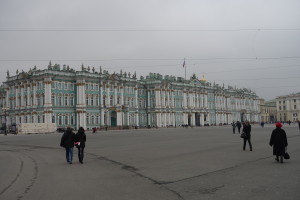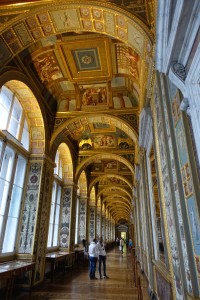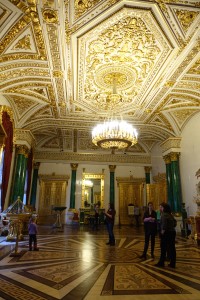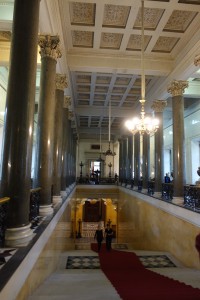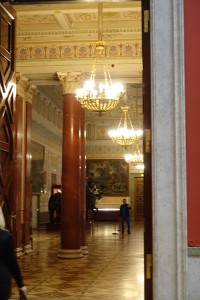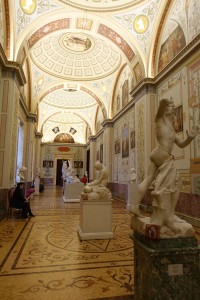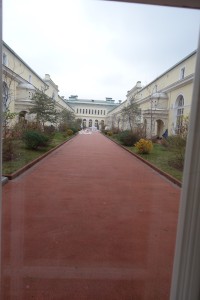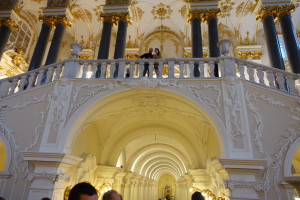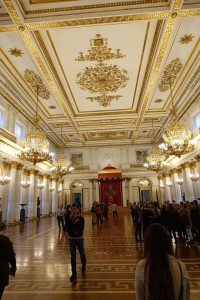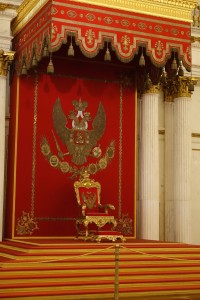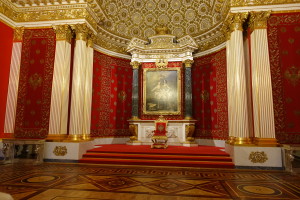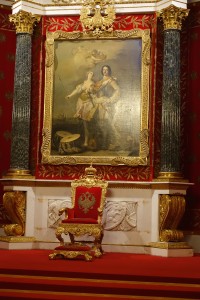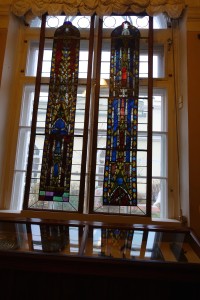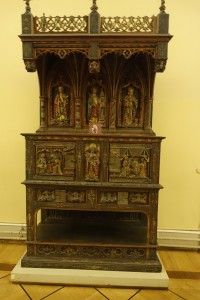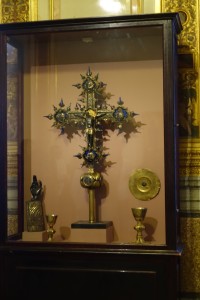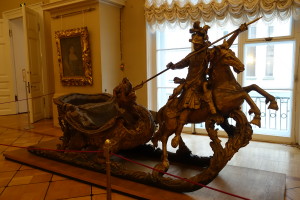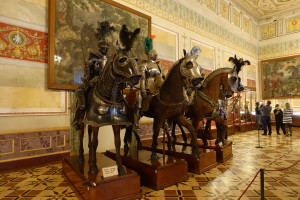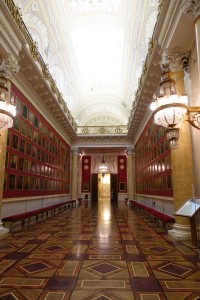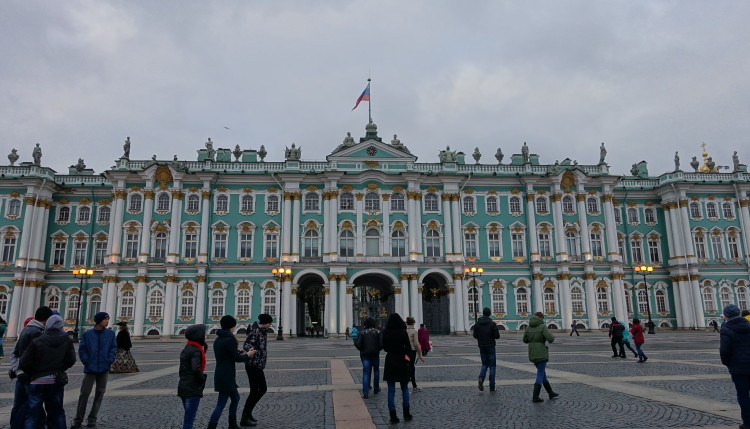
Hermitage Museum
The cold air stinging my eyelashes caused the walk to the museum feel much further away than the six blocks on the map. By keeping my chin tucked beneath the scarf wound loosely around my neck I didn’t notice the museum until I rounded a corner to cross the street. There it was–a gigantic “Tiffany blue and white” building with equally large statues peering down on those below.
Saint Petersburg began out of one man’s dream, yet I don’t believe Peter the Great imagined this building in front of me. Peter’s love of ships, stars and technology developed and grew while spending several years as a teenager in England. Dreaming of building his own navy Peter returned to Russia determined to do so. He sought to transform Russia into a major European power–one reflecting the might and power of a Russian Tsar, replete with ships and sailors. Towards that end, on May 1, 1703, Peter the Great conquered the Swedish fortress of Nyenskans (on the Neva River) and renamed it after his patron Saint and Apostle, Peter.
A new Russian capital slowly arose out of the cold, dark swampland along the Baltic Sea. Architects and builders built canals, roadways and immense buildings in a baroque style (similar to France’s Palace of Versailles). Forty-thousand serfs suffered conscription into harsh labor each of the next twenty years of construction.
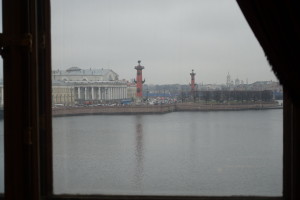
The view of Neva River from the Tzar’s Palace–200,000 slaves lost their lives to build an imperial city, worthy of a Tzar.
A thriving capital city needs inhabitants, leaders, and commerce. Towards that end a wise Peter the Great required his own noblemen to simultaneously build their own palaces alongside his own. So, out of the mud arose a majestic city. Amazed at this quick transformation, from sparse villages to a bustling civilized city, visitors considered Saint Petersburg a “wonder of the world.”
Though a strong leader and visionary, upon his death in 1725, this great european city nearly died with him. His wife followed Peter I as leader, and their son briefly took the throne in 1727. But forced to reside in this city half of each year, many aristocrats returned to the easier lifestyle offered in Moscow.
Not until 1730, when the duchess Anna (Peter I’s niece) claimed the throne as her own (third succession following Peter’s death), did Saint Petersburg return as Russia’s capital. With a different motive this strong, determined woman incorporated other mansions into her own; continued expanding until her personal surroundings contained enough gold and jewels befitting her extravagant lifestyle; and replaced Russian vodka with wines from Europe. Upon her death, Peter the Great’s own daughter, Elizabeth, (another strong woman in Russia’s history) snatched the throne back from Anna’s infant son Ivan IV in 1741 and returned Russia’s culture to this city.
The Imperial school of ballet was instituted in St. Petersburg in 1740 to entertain the imperial court. The Russian Academy of Arts was created in 1757; the Russian Academy of Sciences began in 1724 through a decree from Peter the Great (changed by his daughter Elizabeth to The Imperial Academy of Sciences and Arts in 1747); and Saint Petersburg State University.
Similar to her father’s construction “ideology” Elizabeth’s massive scale of construction ceased only briefly during wars or famine. Finally in 1759, after spending 2.5 million rubles from levying heavy taxes upon the people (workers earned a mere 1 ruble each month) Elizabeth achieved Peter I’s vision of a grand palace within a palatial european styled city.
Enjoying this royal lifestyle for only two years, Anna died in 1762 leaving the throne to her nephew, Peter III. His attempt to change the direction of Russia met with his own assassination just six months into his reign. His wife (former princess Sophia from Germany), known as Catherine the Great, transformed Russia into a progressive and dominant European power during her long (32 years) and successful reign–known in Russia as their Golden Age.
For a time, women dominated and transformed history for two neighboring countries–Russia and Ukraine. With the Christian Orthodox religion integrated into their own personal lives, these female leaders didn’t fear an influx of outside cultural influences, they embraced them. Bringing these countries out of an archaic and barbaric lifestyle took fortitude and direction from God.
Catherine the Great expanded Russia into Alaska (Russian America), down into the Crimean area and across the West into Poland–changing the face of Russia. Transforming finance, education, science, medicine, literature and the arts was no easy task but, I believe, with God’s blessing she achieved her goal and enjoyed more than thirty years as Empress. Implementing a “buying spree” to furnish her enormous palace, it eventually contained one of the most comprehensive art collections in the world.
Each corridor and room so enormous it’s difficult to gauge the space accurately.
Catherine’s agents purchased vast private collections; contracted directly with famous artists; procured statues, furnishings or treasures wherever found (including plundered valuables). She finally achieved her desired goal–not for personal gain, but for an entire country, Russia. The palatial residence rivaled any in Europe; and Russia’s first public museum, contained 3 million works of art (representing every famous artist and sculptor). Numerous works of art (including Michelangelo, Van Gogh, Rubens, Leonardo Da Vinci) lined the walls, often two and three paintings high.
Though christening her own private rooms as “The Hermitage,” the entire palace is known as such.

Built and altered continuously from 1732 until 1917 the Winter Palace eventually included over 1,500 rooms and 117 stairways becoming the largest private, “Royal” residence in the world.
The final Tzar in Russian history–Nicholas–ruled over 100 million people encompassing one-sixth of the earth’s land mass before the losing his reign (and his life) during the country’s long and tumultuous revolution. Beginning with the “Bloody Sunday Massacre” of 1905 (in front of the Winter Palace) and ending as revolutionaries took over the Palace in 1917. Russia now belonged to the “state” as an entity. Bombings, fires and looting by angry mobs (led by the Bolsheviks) caused the disappearance of many treasures.

The site of Bloody Sunday in 1905 where ordinary citizens and orthodox priests were slaughtered in front of the Palace steps.
The excessive riches and lifestyle of the Tzars didn’t “fit” with socialism or Lenin’s ideal for Russia. Much of the personal treasures and art used in the private rooms of the Palace disappeared. Some paintings moved to Moscow museums; masterpieces were sold to private international buyers; some disappeared during German occupation. Nevertheless, the Hermitage is now one museum–some say, the world’s largest–showcasing vast collections of art, antiquities and treasures.
Today, the museum takes considerable precautions lest a visitor steal even one small item. Someone cut a painting out of the frame a few years previous. Russia found the stolen painting, returned it, but extensive repairs changed it. No coats, backpacks, large purses or bags are allowed in the museum area. So, handing my leather and fur coat and purse to a very Russian woman (speaking no English) exchange for a small token, I began exploring.

Truly the most grand stairway entrance, “Jordan Staircase”–every Czar, King, Queen, nobles and every guest surely knew this palace was one of a kind.
If the intention of the Tzar and the Empress was to impress and overwhelm visitors upon entering their throne room, they succeeded. I’m speechless. I’ve walked through quite a few throne rooms, but none with the details of this one–parquet floors, gold ceilings and walls, pillars that go on and on.

A magnificent creation in opulence–a peacock, cockerel and owl fitted with an automaton mechanism unlike anything else in the world…all in gold.
Choosing a tour to learn a little about the history and art in this museum was a wise choice. A very proud English speaking museum guide boasted of the exterior architecture and interior designs of this “one of a kind” palace/museum. Moving from one majestic room into another even greater–all filled with artistic treasures, I knew she must be right. It would take days to see everything inside–larger than the Louvre and more opulent than Versailles. Walking up and down stairways; through large corridors; in and out of these enormous rooms; my mind couldn’t grasp each feature individually. There were so much to see–even ceilings, walls and floors were exquisitely, and artistically, constructed.
Stolen or given freely by a church? Knowing the struggles of the Ukraine and the loss of their church Icons, crucifixes or altars, I highly doubt these churches gave Russia anything, let alone precious items used within the sanctuaries.
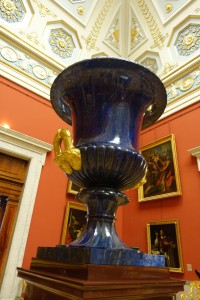
Solid Lapis vase–numerous in this room–along with gemstone tables and inlaid into the floor beneath us.
After two days of touring, I still didn’t see all of it or experience it fully. Knowing Russians were not exposed to art until Catherine the Great brought this vast collection of art to the “Hermitage” I understand her love of all art. She included a theatre for performers (i.e., opera, Shakespeare, orchestras) to entertain. Russian ballet is now world renown because of Empress Catherine’s love of all art and theatre. Science exploded (Sputnik first in space) as did many other western ideas brought to Russia. Much changed.
Yet this Palace, in all its glory, is nearly 400 years old. The plumbing is apparently very inadequate compared to what I’m accustomed. A sign in the ladies bathroom made me laugh:
It felt strange to not be able to discard toilet paper into the toilet. But then I wondered how many people in the world don’t even have toilet paper to use. I discovered that 70-75% do not use toilet paper–they use the left hand to cleanse. Strange, then I found out that 4.2 billion people don’t even have toilets let alone toilet paper–that’s 60% of us. Spoiled, frivolous or truly necessary? When so many don’t have water, how can the thought of a toilet be important? Which leads me to another thought.
How much is too much? In life it is easy to take for granted all that we have right in front of us. Our home, our food, our water, transportation, comforts. The nobility in Russia (as in other countries) expected to be treated “royally”. The attitude and expectation because of one’s monetary position is a dangerous one. But not just this excessive wealth that might cause problems; it’s an attitude of the heart. God sees the heart. Decisions made in our heart are then carried out in the physical world. For good or for evil, it all begins with that heart decision. It is hard to give to others when clutching tight to that which we believe we own or have a “right to it.”
Matthew: 19:23-24 “And Jesus said to His disciples, ‘Truly I say to you, it is hard for a rich man to enter the kingdom of heaven. Again I say to you, it is easier for a camel to go through the eye of a needle, than for a rich man to enter the kingdom of God.'”
Over and over in the Old Testament we are reminded God sees into the heart, tests the mind and gives to us according to what He finds during that search! Traveling gives me a different perspective and insight into my own life. I still struggle with “letting go” of what I think I need to keep.
Jeremiah 17:9-11, “The heart is more deceitful than all else And is desperately sick; Who can understand it? I, the LORD, search the heart, I test the mind, Even to give to each man according to his ways, According to the results of his deeds. As a partridge that hatches eggs which it has not laid, So is he who makes a fortune, but unjustly; In the midst of his days it will forsake him, And in the end he will be a fool.”
If we truly ask God to “give us this day our daily bread” why not let go of what is not needed? or excessive? How many “coats” must we keep for ourselves before we give even one away? How many “things” are enough? I don’t want to be seen as someone holding tight to possessions. God knows my heart, so I pray:
Proverbs 30:8 “Remove far from me falsehood and lying; give me neither poverty nor riches; feed me with the food that is needful for me,”
I returned with my token to retrieve my coat and purse. I look beyond the superficial coverings and possessions to see the real person behind them. In that, we are all the same. We all need a Savior. Our riches do not save us, nor can we “take it to heaven!”
But I cannot really condemn the nobility in Russia. They transformed their country into a Christian nation. When Constantinople fell to the Ottoman Turks, Russia contained more Christians than any other nation in the world. Peter the Great changed the course of his country. Putin is changing his country again. God sees the heart. I pray he strengthens mine as well as those here.


